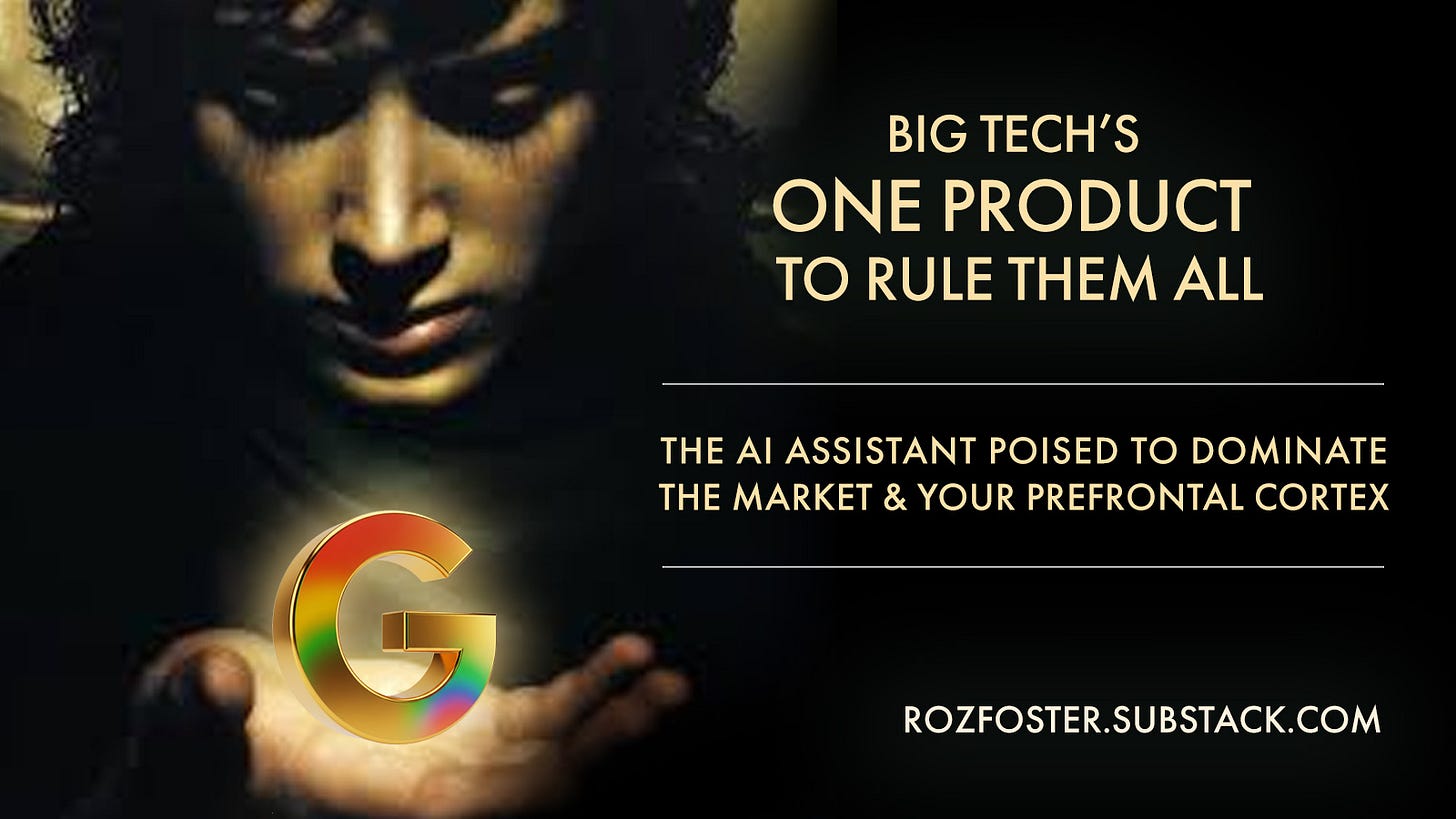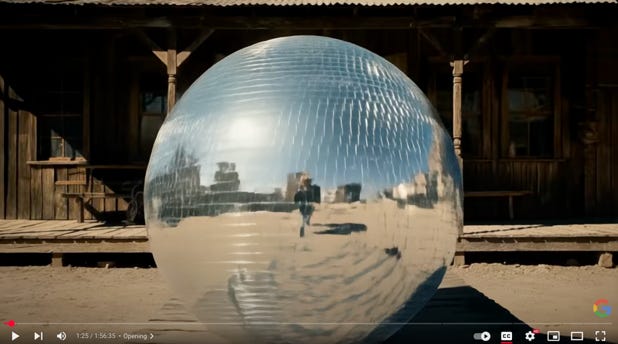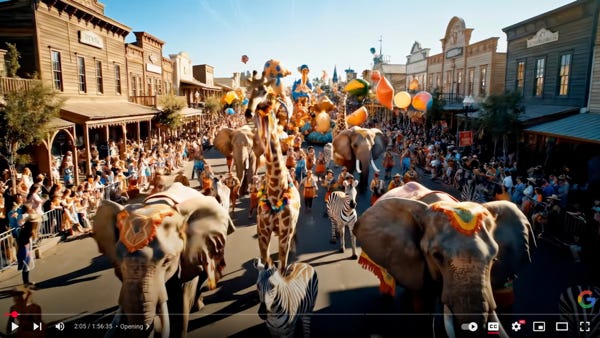Big Tech's One Product to Rule Them All
The AI Assistant Poised to Dominate the Market & Your Prefrontal Cortex
BIG TECH WANTS TO REPLACE YOUR PREFRONTAL CORTEX WITH A CONSUMER PRODUCT. They’ve been flooding the market with AI products, making them easy to use and challenging to avoid. They need you to use their new AI offerings, along with the work-life operating systems and applications you already rely on, to habituate you to them, collect your use-data, and create the ultimate consumer product, a single user interface that unites the suite of products you use and makes all the data you create with those products accessible to the company that owns them.
This one consumer product will be so tailored to your needs and desires that you rapidly come to trust and depend on it to live, work and navigate your life. Big Tech has all of us in their targeting sights but has a particular interest in Generation Z, now teens and young adults not quite thirty, along with the small, pixelated hearts and minds of Generation Alpha, the oldest of whom are young teens. The holy grail is to dominate the US market with the goal of dominating the market for it globally. If you use MS Windows, Office, Apple OS, Google Workspace, or a smartphone with Android or iOS, Big Tech is working hard and fast to replace it all… with One Product to Rule Them All.
This is that product: an AI user interface in the form of a human-like assistant, a helpful companion you’ve come to trust and rely on so much that it’s always on monitoring your activity, including looking and listening to you everywhere you go in your everyday life and work. This AI-driven product is networked across all of your devices and has access to all of your data. This is key: total data transparency. All data and files you create while using its proprietary suite of highly useful products that you can’t live or work without will be accessible, usable for the company’s needs—training, research, growth—with the consumer-facing rationale of empowering you with personalization so that it may proactively think for you and act on your behalf.
Are you a kid, a teen, a young adult and don’t know yet how to think well, how to plan, make good decisions, express your thoughts clearly and persuasively? Fear not, AI is here to remove the need to develop these horribly challenging, yawn-inducing skills! Thinking well is a beast! But now AI can do it for you. Boomers, Gen X and Millennials had to do the awful work of developing and relying on their own prefrontal cortexes to navigate life and work. Oh. My. God. That is so Olde World! The lucky youngsters of Gen Z and Gen Alpha were born at the very best time! As Sam Altman, CEO of OpenAI, said earlier this spring, “kids, hopefully, will never be smarter than AI. They will never grow up in a world where products and services are not incredibly smart, incredibly capable” (TED Talks, April 2025).
Altman’s statement was the premise to a dreamy vision of a world in which your kids will be the inheritors of a new kind of material abundance and have expanded individual abilities. However, that can only be the case if we solve some serious problems here in 2025, and quickly. The start of the next semester of school and university classes is coming up fast. And Altman isn’t considering that the challenge right now is raising, teaching, training, and employing the next generation of young people. Right now, those young people use AI in a way that’s hobbling their ability to learn and think for themselves. While Altman dreams of abundance and limitless human capacity, Sundar Pichai, CEO of Google, dreams their new tech will change lives across the globe. Fantastic ideals. But the young people of today, here and now, whose prefrontal cortexes haven’t yet formed, are using AI in ways that will stunt the development of their executive functions.
THE PREFRONTAL CORTEX IS THE PART OF YOUR BRAIN YOU USE TO REASON, PLAN, AND THINK FOR YOURSELF. It’s responsible for structured, self-driven thought and action. It enables you to do something differently than what’s expected or habitually done – i.e. innovation, improvisation, thinking outside of the box, self-direction, self-rule, autonomy. It manages your ability to resist temptations, regulate inhibitions and impulses. It controls your working memory, providing the recall you need to start and finish tasks. It allows you to know when to hold your attention and when to switch tasks. It controls your curiosity, goads you on to learn more. The prefrontal cortex is where inspiration arises from. It’s what sparks motivation from within.
If your PFC becomes atrophied or shrinks, as it would if you had a brain disease, or, more simply, if you stopped using it, you’d lose the ability to think, plan and act of your own will. You’d lose the ability to plan your day, write an email, drive your car, make the best purchase decisions for your needs and desires, know the difference between what you need and what you desire, make your own decisions about who to vote for and what policies you support. You’d lose your ability to regulate your emotions. You might even lose the ability to truly know what you wanted in life, what your dreams were, what kind of ice-cream you preferred. You could lose touch with a reason to even get out of bed.
Big Tech is pretty much competing on the market to replace your prefrontal cortex with a consumer-facing user interface. Not only are these companies vying for the dominant position previous software has long had here, they’re pushing into the market that your brain has had cornered since the invention of tools. They’re telling you AI does everything your prefrontal cortex does, only better! Big Tech is flanking your brain on the free market and wants to convince you that your gray matter is out of date. There’s no longer any need to use your capacity for executive function! Discard the unwanted chore of organizing your thoughts, making your own decisions, or accessing your own working memory. You’ve been freed from the work of coming up with new ideas, innovative solutions, or the ability to think your way out of persisting problems. AI will reason for you, plan any course of action, do your shopping and help you understand the political scene. The prefrontal cortex is such tired, ancient tech. It’s slow, gray, shriveled and wet. It’s not just outdated, it’s disgusting!
GOOGLE I/O 25 KICKED OFF WITH THE METAPHOR OF A NEW FRONTIER. The opening video at the annual product release event began with a cowgirl created by Google’s game-changing video generator, Veo 3. On horseback, she’s dirty, sweaty, serious—and seems remarkably human. We see a distant, wide-shot of a dusty, western pioneer settlement, as if looking down into the valley from a high ridge. With a fierce look in her eye, our cowgirl says, “This town ain’t seen nothing yet.” You understand the western town is an allegorical Silicon Valley about to be revolutionized.
The song “You Get What You Give,” New Radicals, kicks in, alternative rock from the late 90s. We see a simulation of an old Hollywood lot, like Western Street on Universal Studios’ backlot, itself now an obsolete sim of the American wild west. The red-brown dust of the desert is set against equally generated, but brightly colored wild animals, all of which move and breathe with stunning realism—a flamingo, an elephant, a giant rubber ducky in an abandoned horse-drawn carriage. You can’t help but think about how the steam-powered horseless carriage and the dawn of the industrial revolution made that wooden contraption obsolete. But there’s no time to think about history—there’s a bright tiger napping in a dark barn! A chrome ball rolls out of a saloon and is coming right at the human figure, perhaps the cowgirl, reflected in its curves. (Chrome. Clever. I get it. But a silver ball flying forward at a human being in a western town? Seems a bit ominous.)
A couple of zebras, pairs of tigers now, are vaguely biblical as we begin to understand there’s a gathering of animals. Is there more than a world-changing flood of AI products coming? A giraffe and a toucan watch from a store front window. When the town’s water tower explodes with pastel rainbow powder and the music crescendos, it’s on! A bunch of multicolored balloons float up from behind the General Store. Giant lollipops stand upright in the street alongside an enormous chocolate bar. Gummy bears fall from the sky. And now we’re essentially attending Google’s Main Street Electrical Parade! Who needs Disney anymore? We have Google!
Who even needs a higher power than Google at the very dawn of creation? Giant generated animals walk in procession, confetti falls over giant rhinoceroses in red and blue bowties. A laugh-cry emoji in a window enjoys the parade with infinite glee as the New Radicals serenade the red candy-coated heart-eyes of us all, but mostly woo Gen Z and Gen Alpha: “You’ve got the music in you. Don’t let go. You’ve got the music in you. One dance left. This world is gonna pull through. Don’t give up. You’ve got a reason to live. Can’t forget. We only get what we give.”
The lyrics are pretty dire for Google I/O, no? They seem directed at the kids of Jonathan Haidt’s The Anxious Generation (2024). The kids filled with so much existential dread that, as in the song, they might “smash a Mercedes every night…. You feel your dreams are dying.” Oh, wait, Google left those lyrics out. Instead, they included of a far milder message that, hey, kids, you do have a reason to live. Google. Google’s the reason. The chorus, “We only get what we give,” makes you wonder: Do you mean we’ll only get what we give in terms of, like, how much personal data we give you?
(Here’s a link to the two-hour event, with the two-minute video at the start.)
GOOGLE I/O’S PRODUCT DROP WAS A VERITABLE ELECTRICAL PARADE OF REVEALS AND RELEASES. Top leadership gave presentations reminiscent of Steve Jobs and his team regaling the masses with the next big thing. A stark shift in the force in Silicon Valley was made even more evident this week with Apple’s WWDC 25 release featuring design changes, such as a new wallpaper experience. Meanwhile, the drops from Google were earth-shaking, like Veo 3, Google’s text to video generator. Veo 3 has an astounding grasp of human expression, movement, and physics, and has synchronized sound. Veo 3 coupled with Flow, a ground-breaking editing interface that generates continuity from scene to scene, is an innovation that’s since been causing panic across the visual media industry. Fast-paced attempts are currently in the works to pivot hard into massive reconfigurations of industry business models.
Veo 3 with Flow wasn’t even the crown jewel of the release. The peering eye at the top of this pyramid was the revelation of Google’s plan to roll out a “universal AI assistant,” building on the foundations of Project Astra (a multimodal AI assistant currently in prototype). Pichai articulated the vision on stage, making Google a potential first-mover and the most capable of executing on the delivery of the holy grail of the all-encompassing AI assistant detailed above—One Product to Rule Them All. It’s a user interface that’s synched across all of your devices with access to all of your data in an always-on, always watching and listening, multimodal experience—it’s the experience of a user interface represented as a trusted human-like helper that knows you and permeates every aspect of your life.
Overshadowing Apple’s Siri and Amazon’s Alexa, Google has burst into the lead as the most capable of delivering the One Product. They don’t even have to develop, iterate and ship much because all of the services and apps for the interface are already there. All they have to do is synch them up. Google already dominates in the market for younger generations’ most relied upon apps and tech. The younger gens have been habituated to using and integrating Google Workspace apps and services for free, like Gmail, Chrome, Sheets, Docs, Calendar, Meet, Android OS, etc. (As an aside, they use Apple iOS, too, but my guess is, unless Apple’s CEO, Tim Cook, is hiding preparations for a successful Hail Siri pass, the iPhone may get knocked down a peg by phones that run Android OS.)
All Google has to do is connect the new user interface to the apps you already use and you’ll have, in Pichai’s words, “a new kind of AI, one that’s helpful in your everyday life, that’s intelligent and understands the context you’re in and can plan and act on your behalf across any device. This is our ultimate vision … a universal AI assistant, an AI that’s personal, proactive, and powerful.” Personal, proactive, powerful. The refrain was repeated slowly and carefully throughout the two-hour event. Google’s vision for a universal AI assistant is one that has full access to all of your PERSONAL data, will PROACTIVELY think and act for you, and they want to persuade you it’s emPOWERing you to expand your abilities.
However, right now, it’s poised to atrophy the prefrontal cortexes of our youngest, whom Google is openly targeting, marketing this tech at them full bore. It may have the potential Google hopes for, but it also has the potential to cripple young people’s ability to learn and think on their own. It might become a net gain in the expansion of human abilities in the long run, and there are certainly potentials for science and medicine. But it also has the potential to wipe out entry-level, white-collar employment, devalue the worth of college degrees, render recently hard-won degrees in the arts, media and marketing moot, and make countless, long-held jobs across the media industry redundant. What of this new tech is experimenting with generating rapid, revolutionary solutions for that?
Shortly, there may be a lot of unemployed young people taking to the streets. The issues won’t be confined to what’s currently driving protesters into the streets of L.A. A broad crisis of meaning and purpose, a loss of sense and stability, has been running rampant through our culture, particularly through our youth. That crisis hasn’t yet been fully publicly expressed. Rather than generated zebras in pairs and crowds of flamingos, real live young people are primed to gather, anxious, depressed, and angry. They’ll have little else to do with their time, energy and fury. They won’t have a great deal of impulse control and, listen, they may not be able to think so well. They were told their futures would be filled with bright, confetti-filled skies, and that it would rain candy. Instead, they’re gathering to march in a different kind of parade. If this world is going to pull through, we have got to offer the next generations a future to live for, one that’s real.







I'm waiting. Thanks!
Thank you for this cold shower of quasi übermensch lucidity. Any idea what could we do about that?